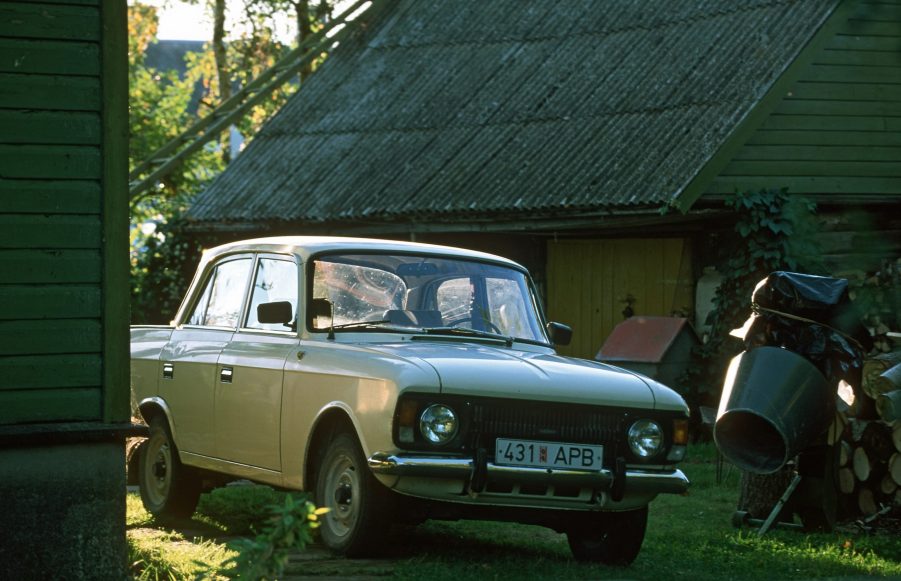
Russia Reluctantly Revives Soviet Car Icon Moskvich
Every so often, a necromancer tries to break into the auto industry. Sometimes, they successfully resurrect a long-dead brand, such as Bugatti. More often, though, the attempt fizzles. But regardless of the outcome, most of these eldritch rituals don’t have government backing. However, that’s exactly what’s happening over in Russia thanks to its invasion of Ukraine. Left with little choice when it comes to cars, Russia is reviving a brand from its Communist days: Moskivch.
When the Soviet Union needed economy cars, it turned to Moskvich

While some European car brands remain unknown to most Americans, Soviet cars are usually even more enigmatic. You might know the Fiat 500, for example, but do you know the Fiat 126p? Or what about the Lada Riva, one of the best-selling cars ever? But before Lada or the 126p ever rolled a tire, the USSR released the first Moskvich.
Moskvich, aka ‘Moskvitch,’ means ‘native of Moscow’ in Russian; appropriate, given its origins. Before WWII, the Soviet company AZLK churned out Ford Model As and AAs as well as its own two-door designs at its Moscow-based ‘MZMA’ factory. But after the war, AZLK got some goodies from a German Opel factory via war repatriations. It then reverse-engineered the 1938 Opel Kadett into the first Moskvich, the 1947 Moskvich 400. And a few years later, it introduced the more powerful 401.
Eventually, Moskivch started engineering its own original designs. The first was the 1956-1965 402/403/407 series, which were also the first Soviet cars offered in multiple trim levels and bodies, Motor1 says. They were also fairly advanced for the time, with independent double-wishbone suspension, 12-volt electrics, and telescopic shock absorbers.
This sounds pedestrian today, but in a 1960s Communist country, it was cutting edge. Also, according to my parents, who grew up in Communist Poland, a Moskvich was basically a Hyundai or a Toyota. Essentially, a reasonably-priced economy car. Though given how long Trabant waiting lists were, ‘reasonably-priced’ is a relative term. But still, they were meant to be functional, not fancy.
Admittedly, Moskvich’s later work was rather less cutting-edge. The 1960s 408, for example, had so many defects that even Soviet authors described it as terrible. Also, it didn’t release a front-wheel-drive car until 1986, when it partnered with French automaker Simca to make the 2141 Aleko. For the average USSR citizen, a FWD hatchback with rack-and-pinion steering and four-wheel independent suspension was groundbreaking. But that was par for the course in the West.
Desperate for cars, Russia is bringing the brand back from the dead
The 2141 was also Moskvich’s last major design. Although it hung around after the Soviet Union’s collapse, it closed its doors in the 1990s. And shortly after, the MZMA factory closed, too, until Renault started making its cars there. This brings us neatly to the present day.
Renault, like several other automakers, has stopped doing business with Russia following the invasion of Ukraine. It hasn’t just stopped making cars in Russia, though. Renault also sold all its shares in Renault Russia and its stake in AvtoVAZ, which owns Lada, Motor1 reports. That leaves Russia without cars and the MZMA factory on the brink of closure—again.
However, rather than close it, Moscow Mayor Sergei Sobyanin has decided to nationalize it. Furthermore, rather than making Renaults or Ladas, MZMA will once again build Moskvich cars. And because Russia is basically on its own right now, Russian truck company Kamaz will be Moskvich’s main technological partner.
Will the Soviet-era brand return for long?
Although Moskvich’s resurrection is intriguing, the brand’s second life might not go smoothly. For one, while Sobyanin has plans to make gasoline-powered and electric cars, the factory doesn’t have any tooling yet. And as noted earlier, Russia invading Ukraine has left it without Western manufacturing support.
Theoretically, Russia could source parts and production equipment from China, Autoweek muses. This would also give native Chinese automakers the greater international foothold they’ve been vying for. But signing all these contracts and setting all that equipment up won’t happen overnight.
And even then, Autoweek notes that Russia could have revived Moskvich earlier. Yes, having no foreign competition is helpful. But the invasion hasn’t exactly alleviated supply chain issues. In other words, forget building cars, just developing them is going to be a tough, time-consuming process.
So, does this mean Moskvich has risen only to die again? We’ll have to see.
Follow more updates from MotorBiscuit on our Facebook page.


